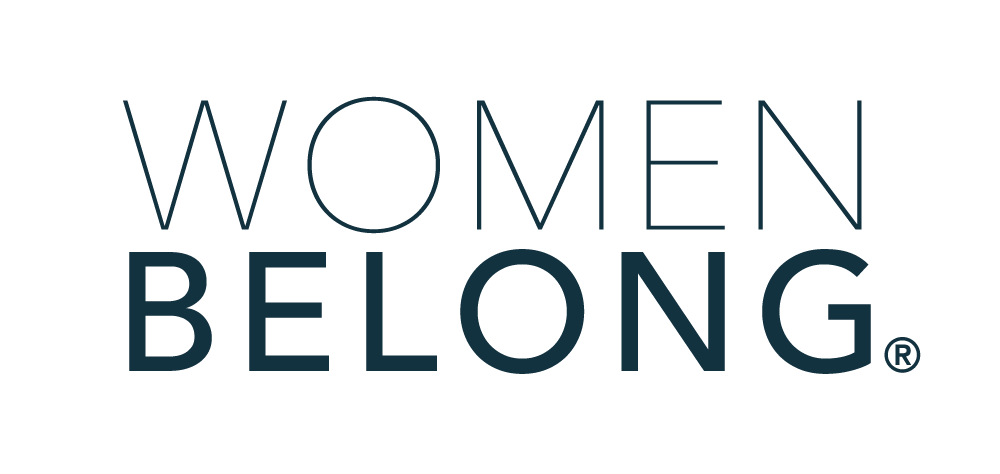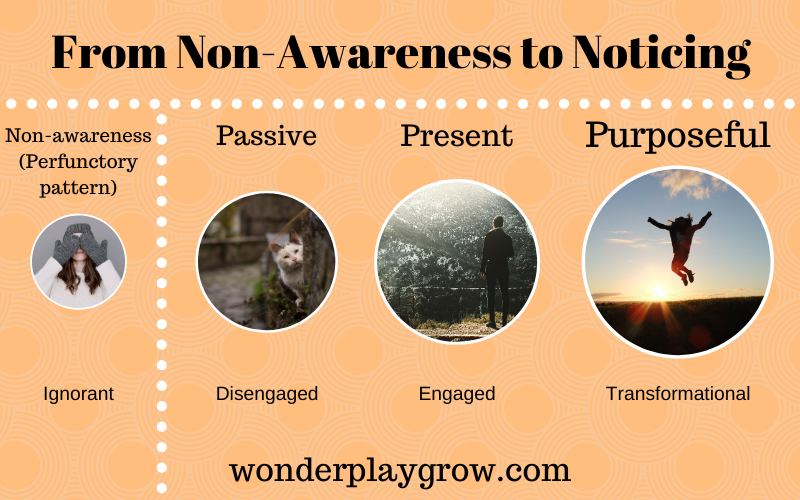Becoming Your Best, Step One: Notice
How many things do we ignore when there’s not a “problem?” Things that we call problems can take up a large portion of our attention, along with the urge is to solve it. Scratch the itch. Patch the leak. Ease the pain.
On the path to Becoming Your Best, however, we’ll need to notice a little deeper than that – because it’s about optimization. We’re not talking about surviving here – we’re talking about thriving – deep, full-bodied, open-hearted living. Even flitting from pleasure to pleasure gets a little empty after awhile. So I invite you to Be the Cause of your Being in Step One: from Non-Awareness to Noticing. Further, I invite you to deepen your noticing – from Passive to Present to Purposeful.
What’s the big deal about intentional noticing?
Before we take on anything new or different, even if it’s supposed to be wildly good for us, we want to imagine the effect on the systems that already exist. No matter how brilliant or seemingly universal a solution or system may look, it doesn’t operate in a vacuum. Every person has their own considerations, and therefore their own path. You would be appalled if a doctor prescribed any medication or recommended surgery without a thorough examination, analysis, and diagnosis – let alone the knowledge of any side effects or contraindications. Doctors are also keenly aware that if they miss the mark, the impact of “malpractice” is a very big deal. We also have punishments in the business world for “false advertising.” If we held ourselves to the same standard (speaking only truths and educated opinions, enacting only helpful recommendations in service of ourselves and others), imagine the qualitative effect! We’re probably not going to be sued by anyone else, least of all ourselves, for ordering an unsatisfying dish, or being in a toxic relationship too long, or missing our life’s purpose for a decade. But the effect of routinely dismissing the notifications, or numbing the pain, or dulling the sensation, or snoozing the alarms, is that we miss our maximum capacity for life.
Take the difference between school-as-factory (everybody receives the same thing, the same way) and differentiated learning (every student is an individual and receives what they need), and even the leap from there to a collaborative environment that helps each student discover how they learn best and supports them pursuing their interests (ie the Montessori model). Could we treat ourselves so generously? What would happen if we were really willing to learn about what is going on right now in our experience of the world, and get in touch with our heart’s desires in a deeper and more genuine way?
Limitations to Noticing
- It only works in the present. Past evaluations may or may not be valid. It’s never one-and-done. It’s continual. So while you may want to congratulate yourself for compassionately appraising how your mother triggered you this time, it’s not a good idea to rest on your laurels and excuse yourself from the table with a blanket statement about what kind of relationship you have with her. Count on people and circumstances to evolve.
- If you’re looking for something, you’re more likely to find it. Confirmation bias is real. Focus or fixate on something and you’ll see it everywhere. Even when you think you’re noticing casually, you take an active part in creating your environment based on what you tend to see.
- Assessments can only measure what they’re designed to measure. A well-designed tool for noticing can really help – as long as it lines up with what you care about noticing. Learning your Hogwarts house won’t help you learn your love language – and neither piece of information will necessarily tell you what went wrong in your last relationship. This doesn’t prevent you from drawing conclusions from a misapplication of an assessment – so use care when you pick what tools to use. Decide what you care about noticing – which is already something to notice.
- All the noticing in the world does not produce results alone. I’m highlighting the importance of noticing as a first step, but it’s not everything.
How To Practice Noticing?
Here are some ideas to start moving along the scale from Non-awareness to Noticing.
|
Non-awareness |
Noticing | ||
| Passive | Present |
Purposeful |
|
|
Not aware of physical feelings or sensations in the body. |
Notice that you have a body. Sometimes it feels good, other times it feels irritable. Notice some of the stimuli that affect your body. | Notice the effects (what it feels like) when certain conditions are met or not (sleep, nutrition, exercise). |
Notice what type of nourishment, rest, and activity – and in what proportion and timing – helps you feel your best. |
|
Not aware of your emotional landscape. |
Notice that you have emotions. Notice when you need to clean up past messes caused by false or irresponsible expression (or non-expression) of emotions. | Notice which emotions are coming up at any moment, and their relative levels of intensity. Notice the messes you make as you are making them. | Notice how you honor your emotions – is it in an authentic, responsible, heartfelt way? Notice the messes you make before you make them. |
|
Not aware of the movement of your mind. |
Notice where your mind goes. You can observe the content of your thoughts and notice patterns. |
Notice the effects of your habitual mental patterns, both desirable and undesirable. |
Notice that you can change your manifested outcomes by changing your habits of mind. |
| Not aware of your environment. | Notice what’s going on in your surroundings (home, work, family, friends, etc.). | Notice the contribution of your environment to your well-being, both positive and negative. |
Notice what elements of your environment or circumstances you would choose to maintain and which you would change, with clarity about the intended impact. |
Concrete Noticing Practice
- Perform a body scan:
- tune in to each part separately (top to bottom) and the whole
- include your vitals – quality of breath, heart rate, temperature, perceived tension, etc.
- Complete an audit:
- Thoughts: observe what you are thinking.
- Emotions: take stock of your feelings, moods, and attitudes.
- Behaviors: what are you doing? What have you been doing?
- Relationships: what are the gifts and challenges of relationships in your life?
- Values: what has been important to you lately?
- Resistance: what have you been resisting lately?
- Wants & needs: how do you want or need to be cared for?
- Deep desires & yearnings: what are the bigger movements of your life geared toward?
- Tune in to your environment:
- Sounds
- Sights
- Sensations
This is a case for continuing your education – to continually and liberally apply your observational skills to your brilliant and beautiful experience, such that you may cultivate a wild and rich garden that produces many fruits in your world and the world of others.
Notice & Zoom: a final note
I believe that we are each a human fractal. If it’s true that “how we show up anywhere is how we show up everywhere,” then we can zoom out or in and ask relevant, useful questions about what we discover. If something is pinging you on a small scale – an irritating sensation, a sudden pleasure – you can ask what it’s about. While it could be true that sometimes a cigar is just a cigar, it could also be true that there is some symptom or sign that there is a bigger fish to fry than we had been aware of. Vice versa: if there is some huge change or shift going on in our world – career change, health event – it could be important to pay attention to how many levels of our experience it is affecting. We might even notice a pattern of behavior – conflict avoidance, neglect of self-care – and find that it’s illuminating to zoom both in and out, to see how it’s affecting our inner world and our outer environment.
Carry on, and happy Noticing!
Content provided by Women Belong member Elizabeth Tuazon











































 Women Belong Holiday Party - ZOOM
Women Belong Holiday Party - ZOOM Why Your Business Wants You To Do Yoga
Why Your Business Wants You To Do Yoga Women Belong Book Club
Women Belong Book Club Why Heroine?
Why Heroine? Follow up with Flow: Creating a Follow Up Funnel that Feels Easy
Follow up with Flow: Creating a Follow Up Funnel that Feels Easy